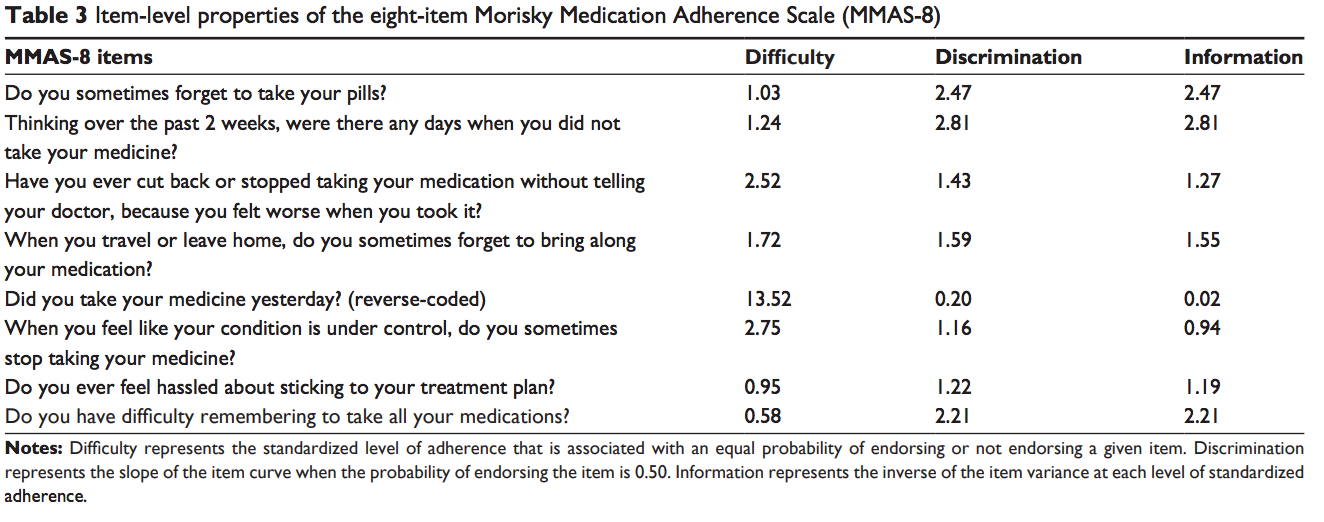Bibliography
Al-Qazaz, H., Hassali, M., Shafie, A., Sulaiman, S., Sundram, S., & Morisky, D. (2010). The eight-item Morisky Medication Adherence Scale MMAS: Translation and validation of the Malaysian version. Diabetes Research & Clinical Practice, 90(2), 216-221.
Arnet, I., Metaxas, C., Walter, P., Morisky, D., & Hersberger, K. (2015). The 8-item Morisky Medication Adherence Scale translated in German and validated against objective and subjective polypharmacy adherence measures in cardiovascular patients. Journal of Evaluation Practice, 21, 271-277.
Ashur, S.T., Shamsuddin, S.A., Bosseri, S., & Morisky, D.E. (2015). Reliability and known-group validity of the Arabic version of the 8-item Morisky Medication Adherence Scale among type 2 diabetes mellitus patients. Eastern Mediterranean Health Journal, 21(10), 722-728.
De las Cuevas, C., & Peñate, W. (2015). Psychometric properties of the eight-item Morisky Medication Adherence Scale (MMAS-8) in a psychiatric outpatient population. International Journal of Clinical and Health Psychology, 15, 121-129.
DiBonaventura, M., Wintfeld, N., Huang, J., & Goren, A. (2014). The association between nonadherence and glycated hemoglobin among type 2 diabetes patients using basal insulin analogs. Patient Preference and Adherence, 8, 873-882.
Kim, J-H., Lee, W-Y., Hong, Y-P., Ryu, W-S., Lee, K.J., Lee, W-S., & Morisky D.E. (2014). Psychometric properties of a short self-reported measure of medication adherence among patients with hypertension treated in a busy clinical setting in Korea. Journal of Epidemiology, 24(2), 132-140. doi.org/10.2188/jea.JE20130064.
Korb-Savoldelli, V., Gillaizeau, F., Pouchot, J., Lenain, E., Postel-Vinay, N., Plouin, P-F.¸ . . . Sabatier, B. (2012). Validation of a French version of the 8-Item Morisky Medication Adherence Scale in hypertensive adults. The Journal of Clinical Hypertension, 14(7), 429-434. doi: 10.1111/j.1751-7176.2012.00634.
Morisky, D. E., Ang, A., KrouselWood, M., & Ward, H. J. (2008). Predictive validity of a medication adherence measure in an outpatient setting. Journal of Clinical Hypertension, 10(5), 348-354.
Morisky, D., & Turbow, S. (2017, Sept 30). MMAS Research. [website}. Retrieved from https://morisky.org/
Muntner, P., Joyce, C., Holt, E., He, J., Moriksy, D., Webber, L., & Krousel-Wood, M. (2011). Defining the minimal detectable change of the Morisky Medication Adherence Scale. The Annals of Pharmacotherapy, 45, 1-7. doi: 10.1345/aph.1P677
Okello, S., Nasasira, B., Wa Muiru, A. N., & Muyingo, A. (2016). Validity and reliability of a self-reported measure of antihypertensive medication adherence in Uganda. PLoS ONE, 11(7), 1-11.
Reynolds, K., Viswanathan, H., Muntner, P., Harrison, T., Craig Cheetham, T. Hsu, J-W., . . . O’Malley, O. (2014). Validation of the Osteoporosis-Specific Morisky Medication Adherence Scale in long-term users of bisphosphonates. Quality of Life Research, 23, 2109-2120.
Sakthong, P., Chabunthom, R., & Charoenvisuthiwongs, R. (2009). Psychometric properties for the Thai version of the 8-item Morisky Medication Adherence Scale in patients with type 2 diabetes. The Annals of Pharmacotherapy, 43(5), 950-957.
Tan, C., Teng, G., Chong, K., Cheung, P., Lim, A., Wee, H., & Santosa, A. (2016). Utility of the Morisky Medication Adherence Scale in gout: a prospective study. Patient Preference and Adherence, 10, 2449-2457.

